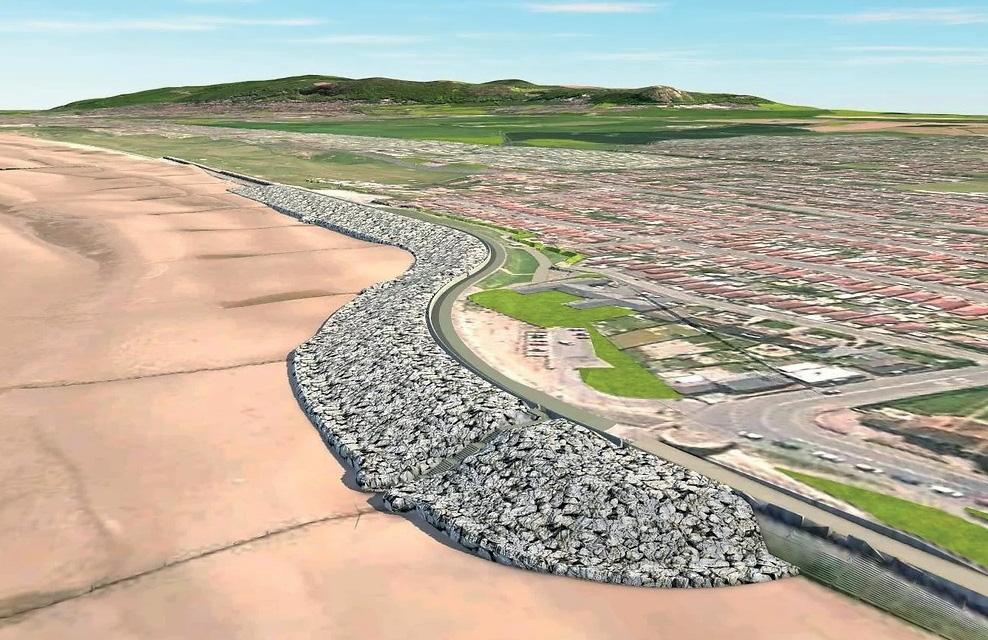
12 minute read
Rhyl defences
EAST RHYL COASTAL DEFENCE SCHEME
Work on a major fl ood defence scheme along the North Wales coastline in Rhyl is scheduled to start in October with the aim of providing protection for 1,650 properties writes Dag Pike
The East Rhyl Coastal Defence Scheme is estimated to cost around £27 million and will be funded through the Welsh Government, combined with part funding by Denbighshire County Council. Work started on site in April to create access points and is on target to be completed by December 2022.
The scheme will see the main contractor, Balfour Beatty, work to place 128,000 tonnes of rock armour in front of the existing sea defences at East Rhyl. In addition, the contractor will construct 600 metres of new sea defence wall and promenade. These defences will help protect the area not only from current storms but also from the anticipated impact of climate change which could see sea levels rise and also an increase the frequency of storms.
Work is progressing well and the preliminary works will have been completed on forming ‘‘ the first of three permanent beach access points. Contractor Balfour Beatty has been able carry on with the work as planned, whilst fully adhering to the Welsh Government’s Coronavirus regulations and guidance, since work started in April
The material which includes large rocks is in the process of being delivered to the site and this will enable the construction of the rock armour revetment, which is scheduled to commence in October. The revetment is expected to take around eight months to build.
Cllr Brian Jones, the Council’s Lead Member for Waste, Transport and the Environment, said: “Work is progressing well and the preliminary works will have been completed on forming the first of three permanent beach access points. “Contractor Balfour Beatty has been able carry on with the work as planned, whilst fully adhering to the Welsh Government’s Coronavirus regulations and guidance, since work started in April.”
A site haul road has been created using the existing promenade between East Parade and Splash Point and a temporary stone track between Splash Point and the Garford Road car park. A stone ramp has been formed at Splash Point to allow access to the beach for the heavy machinery that will be required to carry out the work while a visitor centre has been set up at the site compound and members of the public are welcome to drop by to discuss the scheme with the public liaison officer.
8 Balfour Beatty
will place 128,000 tonnes of rock armour in front of the existing sea defences
McLachlan adds 19 metre multicat
Scottish workboat operator McLachlan Marine has added a 19-metre Multicat to its capabilities of it increasing fl eet.
The Ocean Supporter marks a new departure for this active company and the versatile capability of the Multicat will open up new opportunities in the renewables and marine construction sectors. Previously the activities of the company’s boats were mainly focused on crew transfers and safety boats but the Multicat is equipped to play an active part on marine construction work as well as cargo transfers.
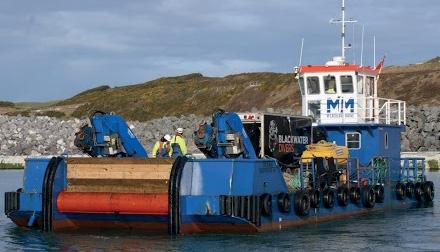
Claimed to be the only vessel of its type in the area, Ocean Supporter is coded by the MCA as Cat 2 for operations up to 60 miles from its base. The open deck of the catamaran can carry up to 40 tonnes of
8 The Ocean Supporter marks a new departure
fl otilla of workboats in order to widen the
for this active company
cargo on deck and it has already used this capability to transfer cargoes to vessels at anchor off Aberdeen and those employed on the expansion project of Aberdeen Harbour.
The Ocean Supporter is equipped two Furakara 500 hydraulic deck cranes at the bow which have extending booms and a further Iron Fist crane can lift 3000kg at 3.4 metres. These cranes are capable of handling lifting operations over the bow such as moorings and pipelines.
3,500T LIFT USED BARGES, PONTOONS AND MULTICAT
Ocean Kinetics has now safely removed all of the remaining structure of the Buchan Alpha oil platform from the water - some 3,500 tonnes of material - from Dales Voe in Shetland
The pontoons are now on decommissioning pads at the Greenhead Base in Lerwick and will be dismantled and sent away for recycling over the coming months by subcontractor, John Lawrie.
Managing director of Ocean Kinetics, John Henderson, said: “We are very pleased to have completed the project safely and ahead of schedule, and it is good to see Dales Voe landscape restored to its natural state.
“The project was much more than just mobilising the heavy lifting barge. We spent several weeks on preparatory work, from initial surveying, then the planning and modelling of the lifting steps. We then moved to the preparation of the rig for demolition while still maintaining the structural integrity. We cut away excess steel, carried out underwater repairs to the pontoons, and attached 24 lifting points each rated to 300 tonnes SWL, to allow the safe removal and placement of all pieces onshore. The multicat vessel Whalsa Lass was used as the main vessel along with various barges and pontoons.
“Utilising the heavy 800-tonne sheerleg crane Hebo Lift 9, we completed all the heavy lifts, both at the salvage site and
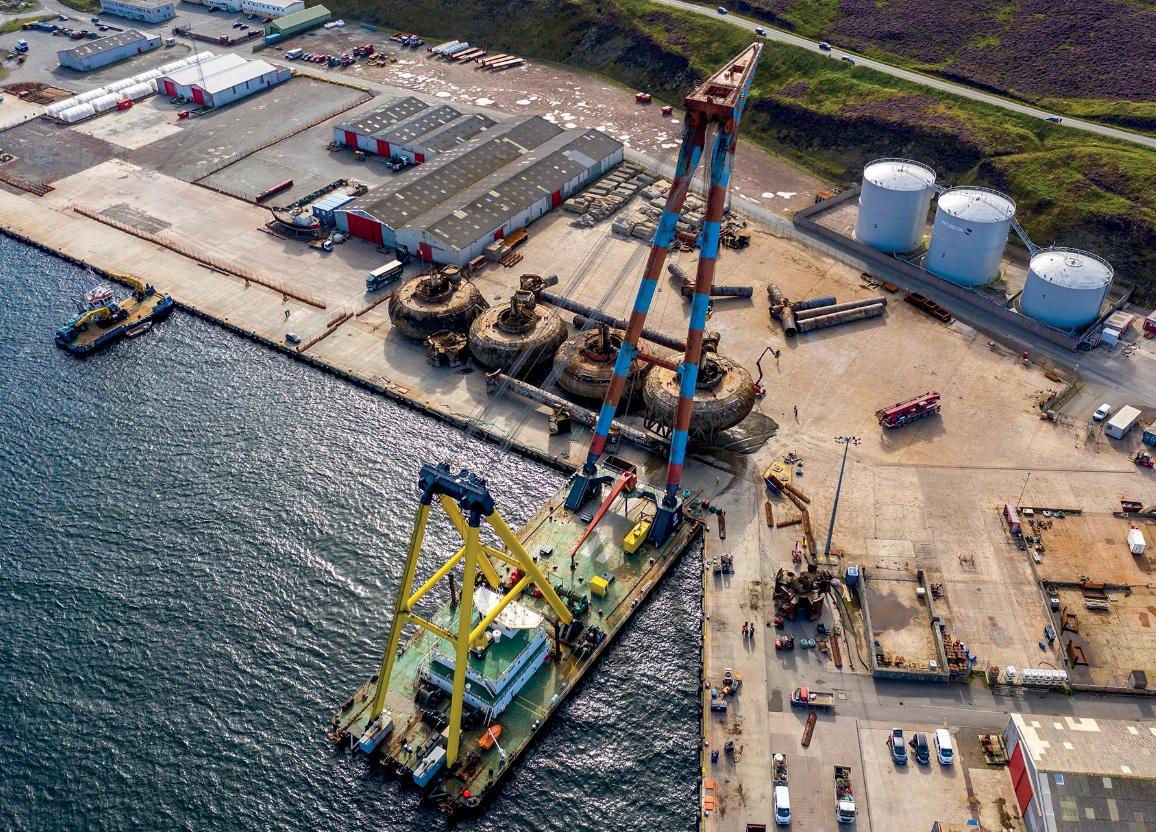
at the Greenhead Base in Lerwick Harbour. Most of the lifts were between 200 and 600 tonnes with the heaviest lift being 765 tonnes.
“The swift and safe completion of this project - in under eight weeks - is testament to the skills and breadth of experience that we have in our team. It also demonstrates our ability to undertake other projects of this complexity, safely, on time and on budget.”
Ocean Kinetics was awarded the contract for the safe removal and recycling of the Buchan Alpha production rig in Shetland by Veolia.
8 The pontoons
are now on decommissioning pads at the Greenhead Base
Southsea scheme commences
Portsmouth’s Southsea Coastal Scheme in the UK is fi nally set to get underway on 7 September with the construction of coastal defences beginning between Long Curtain Moat and Clarence Pier.
The first of six phases in the Portsmouth City Council-led project comes after more than seven years of planning and public consultation. Works will include the demolition of the existing seawall and the construction of a compound area.
Councillor Hugh Mason, Cabinet Member for Planning Policy and City Development, said: “History shows that Southsea has suffered from extreme weather, causing seafront damage and flooding in the past. As our flood defences are ageing,
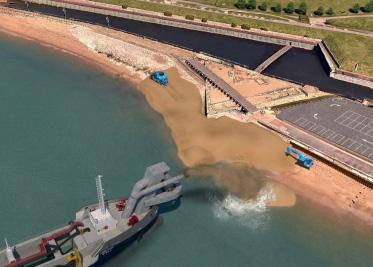
this project is essential if people are to be kept safe.”
The Scheme’s contractor is VSBW, a joint venture between VolkerStevin and Boskalis Westminster.
Neil Dorling, VSBW Project Manager, said:
8 A visual of beach replenishment at Southsea “We are very pleased to be starting work on the coastal defence scheme in Southsea. VSBW will begin the first phase of work between Long Curtain Moat and Clarence Pier in the coming weeks, whilst we finalise plans. We are keen to make a start on this project that will both enhance and protect the area and the community.”
The Southsea Coastal Scheme was given the green light in early 2020 after being awarded nearly £100m of government funding to the project.
In its entirety, the scheme will directly protect more than 4,000 residential and 700 non-residential properties in Southsea from the risk of coastal flooding.
BELGIAN INSTALLATION PROWESS IN DEMAND IN TAIWAN
Jan De Nul Group is well on track in its key parts in the construction of the ‘Taiwan Power Company Offshore Windfarm Phase 1 Project - Demonstration’.
The very first jacket foundations have been installed in Taiwanese waters, approximately 10km off the coast of Fangyuan in Changhua County. Onshore, the civil works for the connection of the offshore wind farm have been completed.
At time of writing a total of nine jacket foundations, weighing approximately 1,100 metric tonnes each, have been installed by the offshore installation vessel Aegir, which Jan De Nul Group has chartered from Dutch Heerema Marine Contractors for the foundation installation campaign.
In total, the TPC Offshore Wind Farm will comprise 21 offshore wind turbines, each installed on a jacket foundation, which are anchored to the seabed by four steel pin piles. Installation of these pin piles started in June this year. After installing the jackets on the pin piles, the void between these two is grouted to create a firm connection.
The 21 jackets have been manufactured at the South Korean Samkang Shipyard Company, and measure between 55m and 62m in overall height.

8 Nine jacket foundations, weighing approximately
1,100 metric tonnes each, have been installed
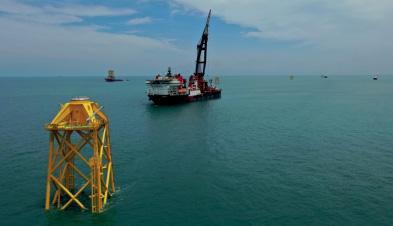
Jan De Nul Group has also completed all the onshore civil works needed for the connection of the offshore wind farm to the Taiwanese power grid. For the connection of the subsea cable at the landfall with the onshore substation of Changhua County, Jan De Nul Group constructed 13km of duct banks in collaboration with the Taiwanese company Star Energy Corporation.
Turbine component installation will commence in August with Jan De Nul’s Offshore Jack-Up Installation Vessel Taillevent.

Teignmouth boatyard plans Teignmouth Maritime Properties Ltd has unveiled its plans for the multimillion pound regeneration of the Riverside Boatyard in Teignmouth, UK with a fi rst 3D visualisation of the project.
Plans for the Riverside Regeneration Project would see the existing Riverside Boatyard at Bishopsteignton Road on the edge of the town be converted into a mixed-use development combining housing, holiday accommodation, industrial units and offices, while vastly improving the existing boat storage and repair facilities.
In the plans which have been unveiled publicly, the development will provide inclusive, accessible living plus working accommodation.


CANALS AND RIVERS PRESENTING ACCESS CHALLENGES
Urban centres are increasingly overcrowded, presenting challenges to contractors completing construction projects in these locations
With many of these works situated along waterfronts, fl oating plant - boats and boat-based construction equipment - may off er a unique solution to this issue. With this in mind, Ian Rothen, founder of The Rothen Group, discusses the benefi ts of utilising Britain’s waterway system in construction.
It is widely accepted that space in London and many other UK cities is increasingly at a premium, yet construction continues unabated. Combined with the ongoing trend towards waterfront living, shopping, and dining, contractors face a unique challenge.
Construction companies can find themselves undertaking work in crowded urban areas, with at least one side of the building works taking place adjacent to water. Many rarely work in close proximity to water meaning many of the processes they take for granted, such as transporting materials to and from the site, become significantly harder.
Additionally, waterside locations pose unique challenges for restoration and maintenance work. This is especially true for buildings with an exterior wall directly along the banks of a waterway, which may require a unique approach.
Aside from practical building and maintenance considerations, there are several waterway-specific restrictions that contractors need to be aware of. Many UK canal towpaths are very old, and were originally designed to bear the weight of horses. As such, construction teams must be careful navigating these paths - something which may prove unfamiliar.
USING THE WATERWAYS
Although building alongside waterways can be challenging, incorporating them into construction processes can bring benefits. Indeed, Britain’s waterways were once the arteries of UK industry, and they can still be very useful to construction companies.
For example, site material transportation can be solved using the UK’s historic canal network. It can serve as a convenient line of transport for specialised marine vessels, allowing construction equipment to reach awkwardly-located sites.
Floating plant positioned in site-adjacent water can prove ideal when moving materials or waste, or acting as a platform to undertake works from. Oftentimes, floating plant can reach sites inaccessible by road, offering tremendous versatility to contractors operating in remote or difficult-to-reach locations.
Similarly, using the waterways to their full potential can help construction teams to complete maintenance and restoration projects more quickly and easily. A range of equipment exists to assist in multiple applications - for example, contractors can use floating pontoons as platforms for scaffolding, from which they can undertake repairs on brickwork or windows, or use survey boats to provide a unique vantage point for site surveyance.
ENGAGING EXPERTS
There are exciting opportunities around using Britain’s waterways in construction, but it is crucial that contractors engage experts to maximise their potential. This is key for locations close to historic towpaths where there are numerous restrictions, ranging from machinery use to pedestrian access. Aside from potential damage heavy equipment and debris can cause, pedestrian access must often remain open if construction occurs in busy towns and cities. Naturally, this can present issues when carrying out works.
Experienced marine contractors like The Rothen Group can help to navigate the various waterway regulations and restrictions. For construction teams coming into contact with towpaths for the first time, this advice can prove invaluable, opening up new avenues to complete waterside building works.
It is also worth highlighting the range of marine construction equipment that exists to parallel its land counterparts. For almost every aspect of a construction project, there is a marine equivalent, including diggers, cranes, scaffolding, and laying cables - all of these are possible by using floating plant.
By viewing the UK’s waterways as a solution, not an obstacle, contractors can quite literally approach waterside construction from an entirely new angle. The breadth of marine equipment that is able to complement and mirror its land equivalent ensures that construction teams can continue to work on projects in crowded urban areas.
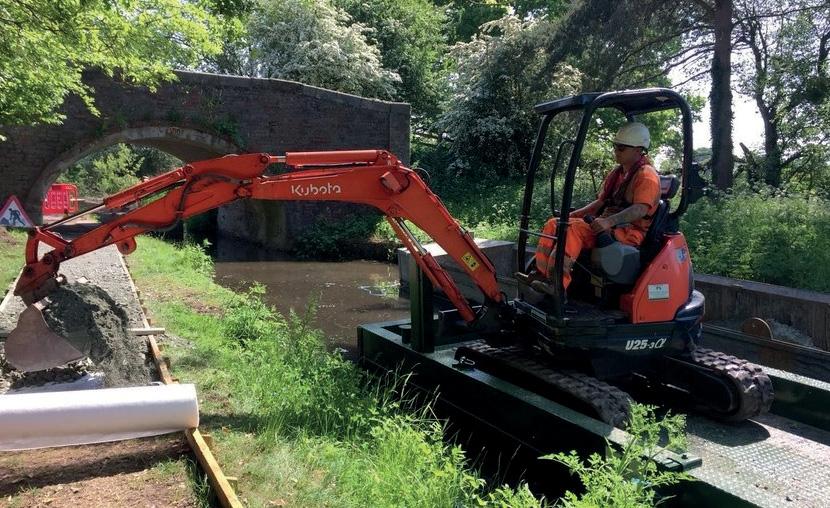
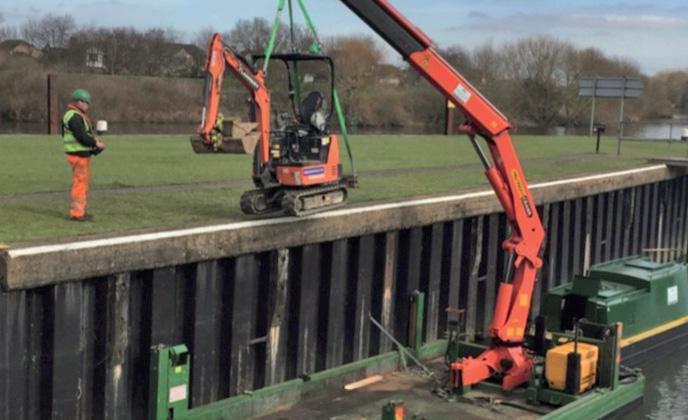
8 Rothen powered
excavator boat
8 Rothen wide

